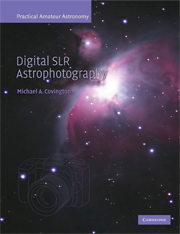1 - The DSLR revolution
Published online by Cambridge University Press: 21 August 2009
Summary
A few years ago, I said that if somebody would manufacture a digital SLR camera (DSLR) that would sell for under $1000 and would work as well as film for astrophotography, I'd have to buy one.
That happened in 2004. The Canon Digital Rebel and Nikon D70 took the world by storm, not only for daytime photography but also for astronomy. Within two years, many other low-cost DSLRs appeared on the market, and film astrophotographers switched to DSLRs en masse.
There had been DSLRs since 1995 or so, but Canon's and Nikon's 2004 models were the first that worked well for astronomical photography. Earlier digital cameras produced noisy, speckled images in long exposures of celestial objects. Current DSLRs work so well that, for non-critical work, you almost don't need any digital image processing at all – just use the picture as it comes out of the camera (Figure 1.1). The results aren't perfect, but they're better than we often got with film.
As you move past the beginner stage, you can do just as much computer control and image enhancement with a DSLR as with an astronomical CCD camera. Some hobbyists bring a laptop computer into the field and run their DSLR under continuous computer control. Others, including me, prefer to use the camera without a computer and do all the computer work indoors later.
- Type
- Chapter
- Information
- Digital SLR Astrophotography , pp. 3 - 13Publisher: Cambridge University PressPrint publication year: 2007



